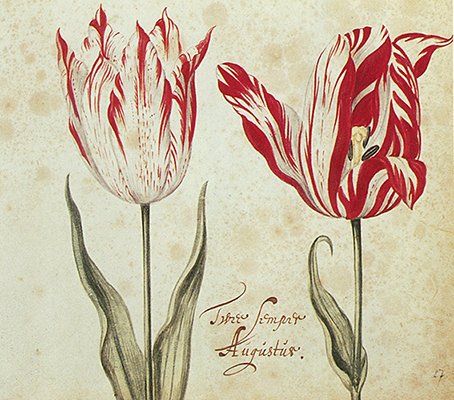tulip Breaking virus: a brief overview
I’ve always been a huge fan of the “weird and wacky” plant varieties, so whenever I see something out of the ordinary in one of our crops, it catches my attention.
One of my favorite floral phenomena on the farm is the tulip breaking virus- where a seemingly normal flower will develop with variegation, “flames”, or streaking, which completely changes the entire look of the flower. We grow thousands of tulips at a time- and these little guys pop up every so often. Last season it seemed like the variety Barcelona had more breaking virus than the other varieties. I loved them and would often plop them into a vase right by my work station. They’re absolutely beautiful, incredibly unique, & the vase life seems to be fine… so what’s the problem? What is breaking virus & why is it such an issue?
A stem of Barcelona with breaking virus- Photo by Karissa Monette
I’m not alone in my love of the “unusual.” Multi Colored tulips have been mentioned in poetry as early as the 13th century. According to the Amsterdam Tulip Museum “In 1250, the poet Mushariffu d-din Sa’di described his ideal garden as an earthly paradise composed of many elements, including “bright, multi-colored tulips…” Throughout the centuries unique tulips were adored, collected, and even used as gifts between royalty and aristocrats to bridge cultural differences.
These beautifully feathered flowers were almost exclusively responsible for the 17th century “Tulip Mania” era and subsequent economic crash in The Netherlands. The rare feathered varieties such as “Semper Augustus” were so prized and sought after, a single bulb would fetch a price higher than the average working salary at the time.
People of all economic backgrounds were involved in the tulip bulb trade. The “bulb bubble” burst when it was realized that these beautifully sought-after varieties were actually the result of a virus, which would ultimately cause the varieties to become sick, fizzle out and die. It was the first real economic bubble and subsequent crash in modern-ish history. “Tulip Mania” is studied in history, economics and finance- as a lesson on what not to do again.
So- what causes this virus?
Dutch growers believed these broken beauties were caused by exposure to extreme random environmental conditions, frequently changing the soil, and/or allowing the bulb to go to seed. Of course none of these hypothesis’ were true.
In 1928, through of a series of experiments, Dorothy Cayley discovered that the “breaking” is a result of a virus. She realized that inserting some “broken” issue into an otherwise healthy specimen could cause the healthy tulip to have breaking virus.
According to the University of Illinois Extension office: “Tulip breaking is due to one or more viruses occurring as strains of varying severity. Transmission of the virus (or viruses) is usually by the feeding of several species of aphids, but particularly the green-peach aphid (Myzus persicae), Macrosiphium euphorbiae, and Dysaphis tulipae. The virus, or viruses, can also be easily spread when, for example, a healthy flower stem is cut with the same knife used to cut an infected stem, or when bulbs are plugged with virus-infected tissue. Transmission through seed has not been reported.”
Over the course of time, the virus has the potential to weaken the tulip, to the point where the bulbs can no longer be grown. This happened with many of the favorite varieties of the time- such as Semper Augustus- a beautiful white tulip with red flames. This tulip no longer exists- it was bred into extinction.
The Dutch believed the tulip breaking virus could be transferred to other bulbs and also had the potential to weaken and change entire crops and varieties. The viral discovery resulted in a ban on broken tulips in The Netherlands, whose economy in part relies on producing high-quality, uniform bulbs that result in a specific flower.
Interestingly enough, some varieties have successfully carried the breaking virus for years and are showing no signs of demise. The oldest of these varieties is the Zomerschoon tulip, which dates back to 1620. Another notable variety is Absalon- which dates back to 1780. Both of these varieties are considered extremely rare heirlooms. (I’d love to get my hands on some of these historic bulbs!)
A true survivor of “Tulip Mania”- the Zomerschoon tulip carries a breaking virus and dates back to 1620
Have any questions or comments about Tulip Breaking Virus? Let us know below!
-Karissa
Resources
TULIP BREAKING OR MOSAIC- University of Illinois Extension, RPD No. 634 September 1990
The Tulip Diaspora- Amsterdam Tulip Museum
Information Cascade and Tuilp Mania- Cornell University
Semper Augustus- University of Chicago



